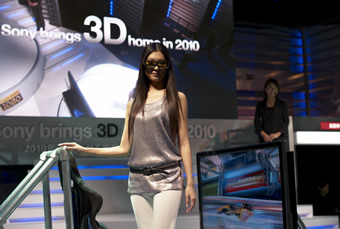Prototype 3D televisions were a big draw at this year’s CEATEC, with Sony, Panasonic, Sharp, and Mitsubishi pushing hard to build consumer acceptance. So far, there’s no broadcast or disc-based 3D standard, either internationally or domestically in Japan, so any 3D television by necessity would have to be a prototype.
The 3D televisions use a field sequential technology (alternating frames), and they require the viewer to wear 3D-enabling glasses that are synced to the video content. The depth effect on the displays was quite good, possibly even better than the 3D television Panasonic demonstrated earlier this year at CES.
With a growing number of motion pictures being released in 3D, there is certainly great potential. But just as no one is absolutely sure if 3D movies will endure theatrically beyond an initial fad, the same is true for 3D home theater. The Japanese manufacturers are forging ahead, assuming the demand will be there when the technology is ready and the standards are in place.
The success of 3D television will largely depend on the success of the theatrical 3D movies. If they fail, broadcasters and other media distributors aren’t likely to assume the risk based purely on specialized content.
